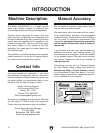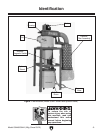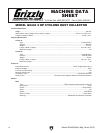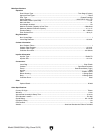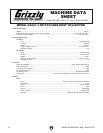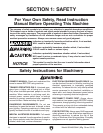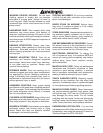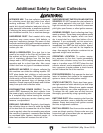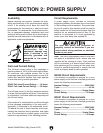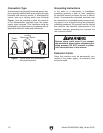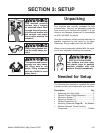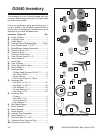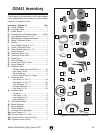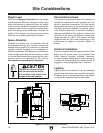
-10-
Model G0440/G0441 (Mfg. Since 03/12)
Additional Safety for Dust Collectors
INTENDED USE. This dust collector is designed
for collecting wood dust and chips from wood-
working machines. DO NOT use it to collect
metal, dirt, drywall, asbestos, lead paint, silica, liq-
uids, aerosols, biohazards, or explosive materials.
Collecting the wrong materials can result in seri-
ous inhalation hazards, fire, or machine damage.
HAZARDOUS DUST. Dust created while using
machinery may cause cancer, birth defects, or
long-term respiratory damage. Be aware of dust
hazards associated with each workpiece material,
and always wear a NIOSH-approved respirator to
reduce your risk.
WEAR A RESPIRATOR. Fine dust that is too
small to be caught in the filter will be blown into
the ambient air during operation. To reduce your
risk of respiratory damage from this fine dust,
always wear a NIOSH approved respirator during
operation and for a short time after. Also, never
collect dust from any type of hazardous material.
IMPELLER HAZARDS. All objects collected by
this machine can strike the rotating impeller. DO
NOT place hands, hair, clothing, or tools near the
open inlet during operation. The powerful suction
could easily pull them into the impeller, which will
cause serious personal injury or damage to the
machine. Always keep small animals and children
away from open dust collection inlets.
DISCONNECTING POWER SUPPLY. Turn the
switch OFF, disconnect the dust collector from
the power supply, and allow the impeller to come
to a complete stop before leaving the machine
unattended or doing any service, cleaning, main-
tenance, or adjustments.
REGULAR CLEANING. Regularly check/empty
the collection bags or drum to avoid the buildup
of fine dust that can increase the risk of fire. Make
sure to regularly clean the surrounding area where
the machine is operated—excessive dust buildup
on overhead lights, heaters, electrical panels, or
other heat sources will increase the risk of fire.
SUSPENDED DUST PARTICLES AND IGNITION
SOURCES. DO NOT operate the dust collector in
areas where explosion risks are high. Areas of
high risk include, but are not limited to, areas near
pilot lights, open flames, or other ignition sources.
AVOIDING SPARKS. Avoid collecting steel frag-
ments or stones. These items can produce sparks
when they strike the impeller, which can smol-
der in wood dust for a long time before a fire is
detected. If you accidentally cut into wood con-
taining tramp metal (nails, staples, spikes, etc.),
immediately turn OFF the dust collector, discon-
nect it from power, and wait for the impeller to
stop—then empty the collection container into an
approved airtight metal container.
OPERATING LOCATION. To reduce respira-
tory exposure to fine dust, locate permanently
installed dust collectors away from the working
area or in another room. DO NOT place the dust
collector where it can be exposed to rain or mois-
ture—exposure to water creates a shock hazard
and will reduce the life of the machine.
FIRE SUPPRESSION. Only operate the dust col-
lector in locations that contain a fire suppression
system or have a fire extinguisher nearby.
STATIC ELECTRICITY. Plastic dust lines gener-
ate high amounts of static electricity as dust chips
pass through them. Although rare, sparks caused
by static electricity can cause explosions or fire.
To reduce this risk, make sure all dust lines are
thoroughly grounded by using a grounding wire.
EMPTYING DUST. When emptying dust from the
collection container, wear a respirator and safety
glasses. Empty dust away from ignition sources
and into an approved container.
DUST ALLERGIES. Dust from certain woods will
cause an allergic reaction. Always make sure you
know what type of wood dust you are exposed to
in the event that this happens.



